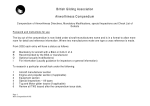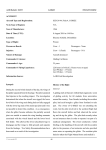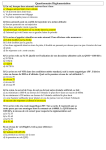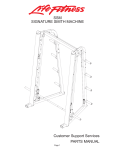Download WINCH OPERATORS MANUAL Revised Edition
Transcript
WINCH OPERATORS MANUAL Revised Edition October 2002 (Web) Winch Operators Manual 1 INTRODUCTION .......................................................................................................2 2 DAILY INSPECTION (DI) ..........................................................................................3 3 SETTING UP THE WINCH ........................................................................................4 4 DAILY INSPECTION OF CABLES AND PARACHUTES......................................5 5 SIGNALS OPERATOR..............................................................................................6 6 CABLE RETRIEVE : INSTRUCTIONS FOR RETRIEVE DRIVERS .......................7 7 LAUNCH PROCEDURES..........................................................................................8 8 EMERGENCY PROCEDURES..................................................................................9 9 CABLE REPAIR PROCEDURES ............................................................................11 10 CLOSEDOWN PROCEDURES ...............................................................................12 11 CABLE RENEWAL ...............................................................................................12 APPENDIX A DAILY LOG SHEET ............................................................................13 APPENDIX B MONTHLY MAINTENANCE .................................................................14 APPENDIX C ANNUAL MAINTENANCE ....................................................................15 APPENDIX D GUILLOTINE SYSTEM - ROUTINE CHECKS .................................16 APPENDIX D SUPPLEMENT .............................................................................................17 APPENDIX E TOST WEAK LINK DATA.....................................................................18 APPENDIX F CABLE CONFIGURATION ....................................................................20 October 2002 (Web Edition) Page 1 of 22 Winch Operators Manual 1 Introduction This manual deals with the theory and practice of launching gliders by winch and is an updated version of the original edition published in June, 1997. This web version omits the theory section – this can be found in the printed version available from the BGA office/ There has been a marked resurgence of interest in winch launching at BGA member clubs for both financial and environmental reasons. If the gliding movement is to recruit younger members, flying training has to be provided at an affordable price. Winch launching offers a low-cost, safe and reliable method of getting airborne. Environmental pressures are steadily increasing and an environmentally friendly and virtually noiseless method of launching gliders is, for many sites, the only option acceptable to the Planners. The development of efficient, high-powered, high-acceleration winches has revolutionised the technique of winch launching, both for the pilot and for the winch operator. The safe exploitation of such equipment has involved a great deal of reorganisation and re-training at many clubs. This manual aims to condense some of the knowledge and experience gained from the practical operation of modern, high-powered Tost winches at the Southdown Club at Parham and the RAFGSA at Bicester. It also embodies some original thought and clear explanations of the theory involved, in the form of articles written for “Sailplane & Gliding” by John Gibson and P.J.Goulthorpe. John Gibson has also written a special contribution on the mechanics of the winch launch. The purpose of this manual is to provide information and guidance to all those involved in the daily operation and maintenance of the club winch. It does not attempt to deal with the instructional aspects of winch launching which are covered more fully in the BGA Instructors’ Manual. The manual has been compiled from first-hand experience, from manufacturers’ data and from qualified expertise. Although aimed primarily at the Tost winch, the principles involved are applicable to a wide range of modern winches and clubs may wish to add their own notes and appendices to apply to specific equipment. Throughout the text, we have endeavoured to explain the principles upon which advice is given and recommendations are made. However, none of those recommendations is a BGA Operational Regulation unless approved by an AGM of this Association and specifically referred to by number in this manual. We shall be grateful for comments and further advice on winch operation which can be incorporated into subsequent revised editions. Finally, our sincere thanks are due to all those who have assisted with this publication. Roger Coote Development Officer October 2002 October 2002 (Web Edition) Page 2 of 22 Winch Operators Manual 2 DAILY INSPECTION (DI) BGA Operational Regulation 4.2 states:All equipment used for launching, including the wire, rope or cable must have been inspected and approved as serviceable each day before being used. Winches and tow cars shall, as a minimum be checked for sufficient fuel, oil and water for the proposed launches and for serviceability of the cable cutting or releasing mechanism Before the first launch of the day, all winches and prime movers are to be given a daily maintenance in accordance with the following schedule:Item Action Fuels Check. Ensure contents are sufficient for the day’s operation. Replenish as necessary. Coolant Check coolant level. No obvious leaks Oils Check levels in engine and transmission Brakes Check operation and brake fluid level Warning Lights & beacons Check warning lights and gauges for correct indication and function. Prime mover and winch cabs Check clear of broken cable and debris. All controls accessible and free. Pay-on gear, all rollers and pulleys Check serviceability and freedom of movement Cable cutting and joining equipment Examine. Ensure serviceable and adequate cleats for day’s operation. Tyres Visual Check Guillotine Operational and checked within last month General Check for oil leaks from engine(s), transmission, drums, pay on gear and brakes Safety Note Check fuels, oils, antifreeze, battery acid and chemicals stored in accordance with COSHH recommendations. Safety Check * * * * * * D.I.Book Complete and record any defects. A glider DI book is adequate for this purpose. October 2002 (Web Edition) Guards Fire extinguisher(s) First Aid kit Earth Stake Wheel chocks Communication equipment (Radio, telephone, bats etc.) Page 3 of 22 Winch Operators Manual 3 SETTING UP THE WINCH SAFETY NOTE If cable runs are near to each other, such that it may be possible for cables to cross, then:(a) Only one glider may be attached to a cable at any one time and (b) After every launch, the used cable must be drawn in to the winch or cleared from the area before another cable is used. 1. Advise the Duty Instructor of the winch status and determine his requirements regarding the positioning of the winch and condition of the airfield, before moving out. 2. Drive the winch slowly to site and align with the launch point. 3. Apply the hand brake firmly on the prime mover and select first gear. 4. Securely position the wheel chocks. 5. Press the earth stake firmly into the ground in a position such that it will not be a hazard. 6. Connect and carry out functional communications check. 7. Ensure the retrieve driver is fully aware of the pull-out and cable break procedures. (See page 9). 8. Obtain Duty Instructor’s permission to pull cables out to launch point. 9. Carry out cable and parachute daily inspection. (See below). 10. When cables have been pulled out :(a) Apply winch drum brake(s). (b) Ensure transmission is dis-engaged. (c) Warm up winch engine to operating temperature. October 2002 (Web Edition) Page 4 of 22 Winch Operators Manual 4 DAILY INSPECTION OF CABLES AND PARACHUTES SAFETY NOTE : While work is being carried out on a cable, the engine should not be run, nor should any cable retrieve mechanism be used. Note: This daily inspection is MANDATORY. The purpose is a visual inspection to ensure serviceability of the whole length of cable to be used CABLES 1. Cut out short lengths of unserviceable cable, worn ferrules and closely spaced joins and replace, using the procedure described under “Cable Repair Procedures”. (See page11. 2. If a new section of cable is required, refer to “Cable Renewal”. (See page 12) PARACHUTES, STROPS AND WEAK LINKS BGA Operational Regulation 4.4 states:The glider end of all launching cables must be fitted with linked rings designed to fit the release mechanism of the glider. Distorted or cracked rings may not be used. 1. Inspect the parachute canopy for wear, tear and security of shroud attachments. 2. Check for tangled, twisted or broken shroud lines. If the parachute is defective, obtain a replacement and enter replacement in the Defect Log. 3. Inspect all connectors, shackles and quick-release units for security, wear and damage and ensure that they function freely and correctly. 4. Inspect the STROP for wear and fraying and check that the shackle attachment to the parachute is serviceable. 5. Inspect the linked rings for wear and / or distortion and their attachment to the strop for security. Replace where necessary. Attach parachute assemblies to the cables. 6. Check the WEAK LINK assembly and that the weak link has not been stretched or distorted. Replace as necessary. The assembly should contain only one weak link at a time. See Appendices E & F. October 2002 (Web Edition) Page 5 of 22 Winch Operators Manual 5 SIGNALS OPERATOR 1. Ensure communication between launch point and winch driver 2. Confirm launch and emergency procedures with the winch driver. 3. Check with winch driver that it is clear ahead & ready to launch. Confirm which cable to use and glider type. Look and see that field is clear ahead. Where would the cable fall, following a cable break? 4. Monitor launch-point for safe operation. Is the correct cable being attached? Are persons clear of the glider? Are persons clear of the second parachute and cable? 5. On “Take up Slack” signal. (Take-off path still being clear) Relay the signal to the winch driver. Repeat verbal signals, as required. Be ready to give a STOP signal. 6. On “All Out” signal Relay the signal to the winch driver. Continue the signals until you are sure that the winch driver can see the glider. 7. Launch Failures Following a weak link break or an instructor-simulated break, the winch driver may require an “all clear” (take up slack) signal, before pulling the cable back to the winch. The broken end is towed to the winch for repair. In either case, in cooperation with the winch and retrieve vehicle drivers, use the established communication system to ensure safe movement of the cables. Be especially watchful during this procedure and keep people clear of the cables, etc. 8. After the Launch-Cable is clear In a multi-cable winch, ensure that the first cable is clear and it is safe to handle the second cable. Do not allow the second cable to be handled while the first is “live” as there is always a risk of the two cables becoming entangled and the second cable thus becoming ”live” also. Confirm to the launch-point when the cable is clear. October 2002 (Web Edition) Page 6 of 22 Winch Operators Manual 6 CABLE RETRIEVE : INSTRUCTIONS FOR RETRIEVE DRIVERS BGA Recommended Practice RP 8 states:Cables get crossed easily on a multiple pull-out. If the pull-out has not been straight, or it is suspected that the cables are close together, they should be separated before the start of the launch......... 1. Wait in a safe area until launching is completed 2. Attach the tow out weak links (350 lbs) to the retrieve vehicle. 3. On signal TAKE UP SLACK Move gently forward. Do not snatch the cables. The winch driver should use the drum brakes to tension the cables, clear of the ground. 4. On ALL OUT signal, accelerate smoothly to retrieve speed Do not move cables if a stop light is showing. Monitor the winch during the retrieve for a STOP signal. If you stop the tow-out before reaching the launch-point, do not start again without a signal from the winch driver. 5. Drive in a straight line to the launch-point. Aim to arrive approximately a vehicles width beside the wing-tip of the upwind glider. If a weak link breaks during the retrieve, then continue with the other cable to the launch-point - BUT ONLY IF NO STOP LIGHT IS SHOWING. Treat as for a cable break. 6. If the cable run deviates from a straight line then inform the Duty Instructor and the winch driver before the next launch. It is important not to launch with a risk of crossed cables. 7. Avoid excessive use of the brakes to stop at the launch-point. This helps prevent the winch drums from over-running. Allow the drag of the cables to bring the vehicle to a halt. 8. Back up the retrieve vehicle to relieve tension in the cables. Allow swivels to stop rotating before removing the cables. 9. For the safety of personnel, the launch strops must be flaked or coiled at the launch point, not laid out. 10. Cable breaks Discuss possible action with winch driver. Carry a tyre on the retrieve vehicle to attach to the “live” winch end of the cable. Return the broken end to the winch only after receiving an all clear (UP SLACK) signal from the signals controller, or after making sure that both the cable and parachute are clear. October 2002 (Web Edition) Page 7 of 22 Winch Operators Manual 7 LAUNCH PROCEDURES SAFETY NOTE:: If there is any jerk or hesitation in power at the commencement of the launch, the winch or car driver must terminate the launch and wait for a fresh set of signals before re-starting. If the pilot suspects over-running or other failure at the start of the launch, he should release the cable at once and treat as a launch failure. INTRODUCTION The objective is to accelerate the glider smoothly and rapidly to its optimum launch airspeed whilst avoiding any snatching which overstresses the cable or tail-banging which overstresses the glider. METHOD 1. Ensure that the engine is warmed up, in accordance with the manufacturer‘s manual. 2. Confirm with the launch controller which cable is to be used . 3. On receipt of TAKE UP SLACK Engage drive. Release brake and adjust revs slowly to take up slack in cable. 4. On receipt of ALL OUT Open the throttle smoothly and progressively to the MAXIMUM SETTING FOR THE GLIDER TYPE AND CONDITIONS. 5. Maintain the power setting until the glider is established in the climb and then adjust to suit glider type, signals from the glider and general impression of speed, rate of climb etc. 6. Reduce power as the glider approaches the top of the launch and close the throttle fully to ensure that the launch is terminated well before the vertical position is reached. 7. Immediately the glider is seen to release, smoothly increase power sufficiently to deploy the parachute, maintain a slight tension in the cable and prevent the cable from touching the ground. This ensures a clean wrap onto the drum with no loose looping. 8. Adjust the power to “fly” the parachute back to the winch, clear of the ground. Once on the ground, the parachute may be drawn closer to the winch VERY SLOWLY. 9. Disengage drive. 10. Advise launch controller CABLE CLEAR, if appropriate. Note on engine handling: After winding in the cable, allow the engine to idle for twenty seconds and then switch off. Repeat sequence for other cables. Retrieve cables to launch-point. October 2002 (Web Edition) Page 8 of 22 Winch Operators Manual 8 EMERGENCY PROCEDURES The winch driver is responsible for understanding how to use the emergency cable cutting equipment. In certain circumstances,an immediate reaction is essential to ensure the safety both of pilots and glider. Emergencies can be considered under the following four categories:I. II. III. IV. Launch failures, including simulated launch failures. Failure of the glider to release on completion of the launch. Launch obstruction. Winch power failure. I. LAUNCH FAILURES Provided that the cable daily inspection has been completed correctly and that there has been no incident which has caused a cable fault, the majority of launch failures wiil be due to failure of the weak link. This means that the parachute assembly will remain attached to the “live” cable and will deploy when the break occurs. Some tension will be maintained in the cable and the cable will lie straight. A break elsewhere in the cable will mean that, due to spring-back, there will be an unknown length of “dead” cable, complete with parachute that has floated down somewhere between the launch-point and the winch. There will also be a length of “live” cable, still attached to the winch. As subsequent actions are dependent upon where the break has occurred, it is important that this should be quickly identified. If possible, the launch controller should advise if a simulated cable break exercise is to be carried out, especially if planned to occur below 200 feet. Launch Failure Procedures (a) Because it is often difficult to determine whether the failure is a weak link or cable break, reduce power immediately to bring the cable to rest and avoid any possible conflict between the glider and the cable / parachute assembly. On no account should the cable be winched in until it is safe to do so. (b) If a weak link has failed, the cable should be winched in for weak link replacement at the winch. (c) If the cable has failed, the cable retrieve crew will retrieve the broken end and return it to the winch, for cable repair. Note: It is strongly advised that following any cable break which involves cable looping or kinking - or if the second cable has been caught or fouled during a launch - a full inspection should be carried out on the cable(s) in question. This may appear to be time-consuming but the delay ensures continuing cable integrity. October 2002 (Web Edition) Page 9 of 22 Winch Operators Manual II. FAILURE OF GLIDER TO RELEASE THE CABLE Providing that the throttle is closed to terminate the launch at the appropriate point, the cable should back-release before it is carried to the vertical position by the glider. Once the cable has reached or passed vertical, it may be assumed that the glider is unable to release the cable. If this happens:Operate appropriate guillotine Apply brake Dis-engage drive Stop engine STAY INSIDE CAB UNTIL EMERGENCY IS OVER III. LAUNCH OBSTRUCTION If at any time there is reason to believe that there is an obstruction or the risk of an obstruction by people, animals or vehicles, the launch should immediately be stopped and no further cable movements made until confirmation is received from the launch controller that it is clear to proceed. SAFETY NOTE: A stationary or falling cable does little damage. A running cable is potentially lethal. IV. WINCH POWER FAILURE If any loss of power is experienced during a launch, the cause should be investigated before another launch is attempted. October 2002 (Web Edition) Page 10 of 22 Winch Operators Manual 9 CABLE REPAIR PROCEDURES 1. Cable repairs must be carried out at the winch, using Tallurit or Intall cleats or ferrules and a hydraulic press. 2. Check that the press has been set up with the correct dies and the correct sized ferrules are stowed in the ferrule box. PROCEDURE 1. Clean cut each end of the cable with the cable cutters, provided. 2. Thread on two ferrules and overlap the cable by 125 - 150 mm (5 - 6 inches) as shown in the diagram below :- 3. Place the ferrule (and cable) between the dies, vertically and centrally. 4. Tighten the release valve and operate the hand pump until the swage faces just meet. 5. Unscrew the release valve to release the ram and extract the formed swage. 6. Repeat for second ferrule. N.B. Time can be saved between pressings by allowing the swages to open only sufficiently to allow the ferrule to be inserted or extracted. ATTENTION - WARNINGS DO NOT APPLY MORE PRESSURE THAN IS REQUIRED TO BRING THE SWAGES FACE TO FACE. DO NOT OVER-TIGHTEN RELEASE VALVE. DO NOT PRESS “FLASH” BACK INTO SPLICE. DO NOT USE ANY FERRULES OTHER THAN THOSE PROVIDED. October 2002 (Web Edition) Page 11 of 22 Winch Operators Manual 10 CLOSEDOWN PROCEDURES 1. Engine OFF. 2. Drive DISENGAGED. 3. Retrieve cables by rotating drums by hand and stow parachutes. Secure free end of cables. 4. Apply winch brakes ON. 5. Switch accessories OFF. 6. Stow chocks and earthing spike. 7. Disconnect telephone cable etc. if appropriate. 8. Enter any defects and operating details in the Winch Log Book. 11 CABLE RENEWAL Cable should be taken from the top of the cable drum to the top of the winch drum or from the bottom of the cable drum to the bottom of the winch drum. Initial Launches The first series of launches with a new cable are critical to its life; at least 20 launches must be carried out observing the following conditions:1. No low or simulated launch failures. 2. No release under tension. 3. Maintain a normal cable load during the launch. October 2002 (Web Edition) Page 12 of 22 Winch Operators Manual APPENDIX A DAILY LOG SHEET DATE/DAY D.I. SIGNATURE MINOR DEFECTS RECTIFIED: DEFECTS OUTSTANDING: RECTIFIED BY: DATE: OTHER NOTES OR INFORMATION NO. OF LAUNCHES: October 2002 (Web Edition) SIGNATURE: Page 13 of 22 Winch Operators Manual APPENDIX B MONTHLY MAINTENANCE At the beginning of each calendar month, all winches and prime movers are to be given monthly maintenance in accordance with the following schedule :Item Action Daily maintenance Carry out daily inspection (See page 3) Guillotine operation Carry out monthly check (See Appendix D) Transmission Check bolts for security Brakes Check operation. Adjust as necessary. Radiator Check cooling ducts free Battery Check electrolyte level and replenish with distilled water. Check battery stowage mounting and terminals. General Clean winch thoroughly. General lubrication as necessary. * Or more frequently, if specified by the manufacturers. October 2002 (Web Edition) Page 14 of 22 Winch Operators Manual APPENDIX C ANNUAL MAINTENANCE All winches and prime movers are to be given annual maintenance, according to the following schedule :Item Action Daily Maintenance Carry out daily inspection (DI). (See page3) Monthly Maintenance Carry out monthly maintenance (appendix B) Brakes Strip and Inspect. Adjust as required Drum Check security of drum nuts. Tighten as necessary. Roller guides Clean complete unit. Check all roller guides for smooth running. Replace all worn bearings and grooved rollers. Lubricate. Engine Oil and Air Systems (winch and prime mover) Change engine oil and filter Service air filter. Ignition system Check serviceability. Replace spark plugs or service injectors. Pay-on gear Check drive belt wear and tension. Fuel system (winch and prime mover) Check the fuel filters. Clean or replace as necessary. Engine Cooling System Check specific gravity of the antifreeze. Check hoses, water pump and radiator ducts. Belt drives Tension belts and renew as necessary. Guillotine Carry out Guillotine Full Functional Check (See appendix D) Structure and Bodywork Inspect body and chassis for damage, corrosion and loose paint. Restore paint surface : use primer, undercoat and finish coats. Prime mover steering linkage Check steering linkage. Checking the amount of free play at the steering wheel will indicate the degree of wear in the steering box and linkage. Rectify faults to ensure safe vehicle handling. Prime mover ball joints Check all steering ball-joints for lift or excessive free play. Rectify faults to ensure safe vehicle handling. Prime mover wheel brake. Check brake pads. Adjust and carry out functional checks. October 2002 (Web Edition) Page 15 of 22 Winch Operators Manual APPENDIX D GUILLOTINE SYSTEM - ROUTINE CHECKS The Guillotine is a vital safety feature of any winch and it is essential that the cable cutting equipment is maintained so that it will work efficiently, if needed in an emergency. There is a wide range of types and it is vital to protect and preserve the cutting edge in order to maintain effective operation. SERVICEABILITY CHECK To ensure correct operation, the guillotine should receive a serviceability check as and when required. It is advised that this check is performed at least once every month. The frequency of this check is dependent, amongst other things, upon the dirt and debris collected upon the guillotine mechanism from the passing cable, it will therefore vary according to the state of the ground over which the cable passes. Check full range of movement and operation of the guillotine assembly and mechanism (without cutting cable). FULL FUNCTIONAL TEST (WITH CABLE) The guillotine full functional test is to be carried out as often as considered necessary to ensure correct operation but at a minimum frequency: a. b. as recommended by the winch manufacturer after any repairs to the guillotine. Operate guillotine system from the winch cab. Ensure that the cable is severed cleanly. If the cable is not severed completely, dismantle the guillotine system, clean and if necessary replace worn or defective parts with sound parts, reassemble and carry out a further functional test. A record of guillotine inspection and testing should be kept on the daily log sheets (see Appendix A). October 2002 (Web Edition) Page 16 of 22 Winch Operators Manual APPENDIX D SUPPLEMENT BEST PRACTICE RECOMMENDATIONS FOR ENSURING THE SAFE AND EFFECTIVE OPERATION OF WINCH CABLE GUILLOTINES D.1 Reliance upon an axe or bolt cutters as the sole method of cutting cables should be discontinued as this is an impractical and dangerous practice, particularly when the cable is moving, highly loaded and vertical (the glider having overflown the winch). D.2 Operational Regulation 4.8 (Laws and Rules for Glider Pilots, June 2003) states that all winches must be fitted with approved cable cutting guillotines. D.3 As a minimum requirement, guillotines should be able to sever a moving, 5 mm diameter, multistrand steel cable or a 3.5 mm diameter, single strand, high tensile steel cable which is not under tension. D.4 Guillotine systems should be maintained in accordance with the manufacturers’ instructions which, ideally, should require them to be cleaned lubricated and have a ‘low-load’ serviceability check every cable change (3,000 launches) or every month, whichever is the shorter interval. D.5 Guillotines should have a full-load functional test once a year, followed by a sharpening of blades and checking for wear, mis-alignment and damage, as recommended at Appendix ‘D’ in the BGA Winch Operators’ Manual. More frequent ‘full-load’ testing is to be discouraged on account of the accelerated wear this would cause to the mechanism. D.6 Guillotines should be fitted with operator protection guards and a foolproof inhibiting system. D.7 Existing guillotine systems should be properly qualified against the requirements, defined above (D.3). Those systems not measuring up should be replaced by an approved system. NB*. D & M Engineering at Shrewsbury (01743 874427) have developed a new guillotine system capable of cutting 3 off 5mm. dia multistrand cables and ferrules for the Skylaunch winch. The unit is modular and should be capable of easy fitting to a variety of winch designs. October 2002 (Web Edition) Page 17 of 22 Winch Operators Manual APPENDIX E TOST WEAK LINK DATA BGA WINCH / AOTO-TOW WEAK LINKS. LAST REVISED SEPTEMBER 1996. TOST COLOUR CODING Black No. 1 Brown No. 2 Red No. 3 Blue No. 4 White No. 5 Yellow No. 6 Orange No. 7 1,000 daN 850 750 600 500 400 300 = 2,200lbs = 1,870lbs = 1,650lbs = 1,320lbs = 1,100lbs = 880lbs = 660lbs N.B. If in doubt, Tost apply a factor of 1.3 X Max. all up weight of the glider to determine weak link strength for winch / autotow. (1KP = 1daN = 1kg = 2.2lbs) Not exceeding KP Astir (s) Single Twin Astir ASH 25 ASK 14 ASK 15 ASK 17 ASK 19 ASK 20 ASK 21 ASK 22 ASK 23 ASK 24 AV.36 Austria Std. Bergfalke 2 Bergfalke 3 Bergfalke 4 Bijave (WA30) Blanik Bocians Breguet 905 BG. 135 Cadet Mk 1 & 2 Cadet Mk 3 (T 31) Caproni A21 Capstan Carman JP15 Centrair 101 Cirrus Cirrus Std. Cumulus Cobra Condor October 2002 (Web Edition) 600 845 900 830 500 600 600 600 1000 900 680 600 600 670 970 1070 750 600 630 1000 600 600 500 500 600 600 600 600 860 600 540 600 1000 No.4 No.3 No.2 No.3 No.5 No.4 No.4 No.4 No.1 No.2 No.4 No.4 No.4 No.4 No.2 No.1 No.3 No.4 No.4 No.1 No.4 No.4 No.5 No.5 No.4 No.4 No.4 No.4 No.2 No.4 No.5 No.4 No.1 Not exceeding KP Dart 15 /17 Delphin Diamant 16.5-18 Discus DG 100 / 200 DG 400 DG 300 / 600 Doppleraab Eagle EON Primary EON Baby ELF S.2 Falcon Fauvel Fauvette 905 FOKA 3 / 4 / 5 Geier 11 Glasfugel 604 Goevier 111 Grunau 5 Gull 1 / 3 / 4 Harbinger Hornet Hutter 17 Iris (D 77) IS 28B2 IS 29 / 30 / 32 Jantar Std. Jantar 2 Jantar 3 Janus B Janus C Jaskolka 500 700 935 650 600 600 680 800 600 500 600 540 500 500 600 720 765 850 1030 540 500 500 500 500 500 600 600 630 600 600 600 750 500 No.5 No.4 No.2 No.4 No.4 No.4 No.4 No.3 No.4 No.5 No.4 No.5 No.5 No.5 No.4 No.4 No.3 No.2 No.1 No.5 No.5 No.5 No.5 No.5 No.5 No.4 No.4 No.4 No.4 No.4 No.4 No.3 No.5 Page 18 of 22 Winch Operators Manual Not exceeding KP Javelot Junior JP 36A KA 1&3 KA 2 KA 4 KA 6 KA 7 KA 8 KA 13 Kestrel 17 / 19 Kite 1.2B Kranich 11 / 111 Kranjanek LAK 12 Libelle (201) Libelle H301 LS 1 LS 3 LS 4 LS 6 LS 7 LO 100 M 100 M 200 Meise ME 7 MG 19A Mosquito Moswey Minimoa Mucha Std. MU 13 Nimbus 2 Nimbus 3 Nimbus 3.24 &3D Nimbus Mini Olympia 1&2 Olympia 460 / 463 Olympia 419 500 600 500 450 600 900 650 1080 668 1080 630 500 960 500 600 600 670 500 600 600 600 600 650 500 600 670 500 950 650 650 500 820 535 600 750 1040 600 500 500 600 No.5 No.4 No.5 No.6 No.4 No.2 No.4 No.1 No.4 No.1 No.4 No.5 No.2 No.5 No.4 No.4 No.4 No.5 No.4 No.4 No.4 No.4 No.4 No.5 No.4 No.4 No.5 No.2 No.4 No.4 No.5 No.3 No.5 No.2 No.3 No.1 No.4 No.5 No.5 No.4 Not exceeding KP Peak 100 Petrel Phoebus (all) PIK 20E PIK 16 / 20 Pilatus B4 Pirat Prefect Puchacz Rheinland Rhonlander 2 Rhonlerche 2 Rhonsperber Sagitta SB 5 SF 26 SF 27A SF 34 S.G. 38 SHK SIE 3 Silene (E78) Sky Skylark 1-2-3-4 Spatz Sperber Suid 111 Swallow Swift T 21 T 31 T 53 / YS 53 Torva Tutor Vega Ventus Viking (V.G.C.) Wassamer W.A.26 Weihe Zugvogel 1&2 Zugvogel 3 Zugvogel 4 600 500 1000 600 530 500 600 500 750 500 500 900 500 600 600 650 750 600 300 700 700 600 500 600 520 1030 500 500 500 500 500 750 500 500 600 650 500 500 670 720 742 690 No.4 No.5 No.1 No.4 No.4 No.5 No.4 No.5 No.3 No.5 No.5 No.2 No.5 No.4 No.4 No.4 No.3 No.4 No.7 No.4 No.4 No.4 No.5 No.4 No.5 No.1 No.5 No.5 No.5 No.5 No.5 No.3 No.5 No.5 No.4 No.4 No.5 No.5 No.4 No.4 No.4 No.4 1KP = 1daN = 1kg = 2.2lbs October 2002 (Web Edition) Page 19 of 22 Winch Operators Manual APPENDIX F CABLE CONFIGURATION Notes on the correct attachment of parachutes, weak-links and towing strops. General Principles 1. The relative position of the component parts is critical. The weak-link should always be positioned between the glider and the parachute, leaving the parachute attached to the cable when the weak-link fails. 2. No part of the parachute assembly and strops should be capable of storing energy. Any elasticity in this assembly can result in damage to the glider. 3. The assembly should contain the minimum number of metal parts to reduce weight and potential impact damage. 4. The assembly must not be able to damage, obscure or become entangled with the glider at any time , especially following a cable-break or weak-link failure. 5. All sections should be capable of quick and easy assembly and detachment. The Component Parts Attachment to cable. The end of the cable is fashioned into an eye by swageing the cable round a thimble which protects the strands from wear. The shackle holds the ends of a fabric strop which gathers together the shrouds of the parachute. Fabric is employed to minimise friction and wear on the parachute shrouds. The canopy of the parachute is attached to the weak-link assembly, using another strop of shroud material. The weak-link assembly incorporates a link to suit the glider being launched (see Appendix E) and this remains with the parachute assembly. ( At some sites, a selection of weak-links, suitable for launching each of the glider types in the club’s fleet, may remain permanently attached to the parachute assembly. This is convenient, but calls for extra care in ensuring that the correct link is chosen for each launch.) N.B. The Tost weak-link system is designed for use either with a single link or with double links. If the double-link system is employed, it is essential that the links are of different design (the main link having round holes and the reserve link having slotted holes). Using two weak links, each of the same design doubles the breaking load and renders the whole assembly ineffective. Because of the risk of assembling two weak links incorrectly, the single-link assembly is recommended as the more foolproof system. A quick-release coupling attaches the launch strop to the weak-link assembly. The launch strop is constructed either of steel cable, shrouded in plastic hose or of heavy hemp rope. It is essential that the strop does not store energy or it may catapult back to the glider, following a launch failure. The length of the strop must be such that it cannot foul any of the control surfaces of the glider, following a failure of the cable or the weak-link. The cable assembly is attached to the glider’s release mechanism by means of a circular steel link which is attached to the launch strop via a larger steel link. Any wear or distortion of either the link or of the release mechanism renders the cable-release unserviceable. It is October 2002 (Web Edition) Page 20 of 22 Winch Operators Manual also desirable that the release mechanism and the attachment links should be of the same make. The use of Ottfur cable rings is no longer recommended due to the risk of permanent distortion or failure when employed at loads in excess of 1650 lbs. October 2002 (Web Edition) Page 21 of 22 Winch Operators Manual October 2002 (Web Edition) Page 22 of 22




































